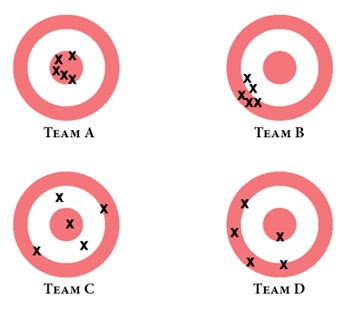Noise #1: What is it?
Errors in judgment. There are two causes for it: bias, and “noise”. In their book titled Noise, the authors start off by explaining what “noise” means in this context. Say 4 teams, A, B, C, and D go to a shooting range:
Team A is on
target. B is “biased” (off-target but in a very consistent way). C and D are inconsistent
– they are what is called “noisy”.
In the real world
though, for most judgments, one doesn’t know what the target is. Or who missed
and by how much. If that sounded wrong, consider a few scenarios of what the
authors mean: Which movie should be made? Which candidate should be hired? What
is the right premium for the insurance policy? In these scenarios, what exactly
is the right answer? And how do you even gauge if the decision was wrong: after
all, each of the decisions could go wrong for reasons that have nothing to do
with poor judgment e.g. a freak earthquake, or a personal event in the
employee’s life that derails his professional life.
Which is why the
authors say real life scenarios look like this. It’s the same shot pattern as
above but without the bullseye circles to tell you what the target was.
Noise, conclude
the authors, is easy to identify in real life. The diagnosis of doctors vary.
Project teams come up with very different estimates of cost and time. Bail
decisions aren’t identical. Which patents get granted doesn’t follow a pattern.
Not only is noise everywhere, but worse:
“In
real-world decisions, the amount of noise is often scandalously high.”
Which is why the authors of the book (and this series of blogs) focuses on the problem of noise in decisions involving judgment.


Comments
Post a Comment